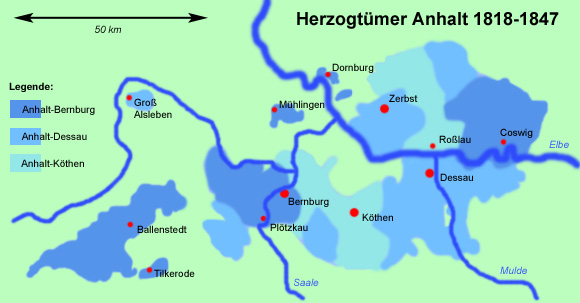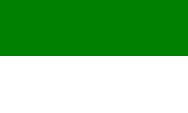




The colors of the Ascanians were red, green and white, but in practice were used almost exclusively white and green, including the flags of the Duchies of Anhalt and their dynastic lines, which should have been furthermore square. The origin of the colors is unknown. It is believed that the red goes back to the red eagle of Brandenburg, the green to the octothorpe in the coat of arms of Saxony, and the white to the initial coat of arms of the Ascanians that showed the colors black and white. The cockades of the country showed only the color green.
Quelle/Source: Historisches Deutschland,
Hof- und Staatshandbuch für das Herzogtum Anhalt, Dessau 1887


1853–1863,
lesser coat of arms Duchy of Anhalt-Dessau-Köthen
Quelle/Source: nach/by:
Wikipedia (D)

1853–1863,
middle coat of arms of the Duchy of Anhalt-Dessau-Köthen
Quelle/Source: nach/by: Wikipedia (D),
Heraldique Europeenne

All lines of the House of Anhalt used the same dynastic, middle coat of arms, and even the same lesser coat of arms. In the 18th century arose for Anhalt-Zerbst and Anhalt Köthen deviations in the middle coats of arms. Anhalt-Dessau and Anhalt-Bernburg retained their same shaped coats of arms.
The coat of arms of the since 1853 existing Duchy of Anhalt-Dessau-Köthen is the coat of arms of the only surviving line, rhe House of Anhalt-Dessau. It is very abundantly partitioned and shows altogether eleven fields, which reflect the heraldic smithereens of the familie's lines or territorial acquisitions: Duchy of Saxony, Palatinate of Saxony, Duchy of Engern, Beringen, Ballenstedt, Askanien, Waldersee, Warmsdorf, Mühlingen, the red regalia field (display of blood jurisdiction) and Bernburg. In the middle of the coat of arms, over field no. 5, a heart-shield. That shows the smaller coat of arms a splited shield, to the left Brandenburg and on the right Saxony.
The Princes of Anhalt were initially even themselves the Margraves of Brandenburg and the Dukes of Saxony, but later even related by marriage with the Electors of Brandenburg and as well with those of Saxony, and claimed inheritance rights in both countries. They combined in their arms the crests of the two often feuding countries, in a so-called claim arms. In this way were not only combined the arms of Saxony and Brandenburg for Anhalt, but also the since 1863 in the Duchy of Anhalt used colours red, green and white are a combination of the colours of Saxony (white and green) and Brandenburg (red and white).
Quelle/Source: Heraldique Europeenne,
Volker Preuß


Quelle/Source: Volker Preuß

Area: ca. 616 square miles
Inhabitants: 124.000 (1861)
Capital: Dessau, 15.000 inh. (1858)
Currency: 1 Taler = 30 Silbergroschen = 360 Pfg.
Quelle/Source: Historisches Deutschland,
Der Michel

23rd of November 1847 · death of Duke Heinrich, extinguish of the in the Duchy of Anhalt-Köthen ruling line of Anhalt-Köthen-Pless, establish of a co-administration of the Duchies of Anhalt-Bernburg and Anhalt-Dessau for the Duchy of Anhalt-Köthen
1853 · annexation of the Duchy of Anhalt-Köthen to the Duchy of Anhalt-Dessau, establish of the Duchy of Anhalt-Dessau-Köthen
1863 · extinguish of the line of Anhalt-Bernburg, annexation of Anhalt-Bernburg to Anhalt-Dessau-Köthen, establish of the Duchy of Anhalt

To explain the origin of the name "Anhalt" there exist various theories. It should point out to a castle, built by Esiko Count of Ballenstedt, without wood (on holt).
Quelle/Source: www.andat.de







![]()






